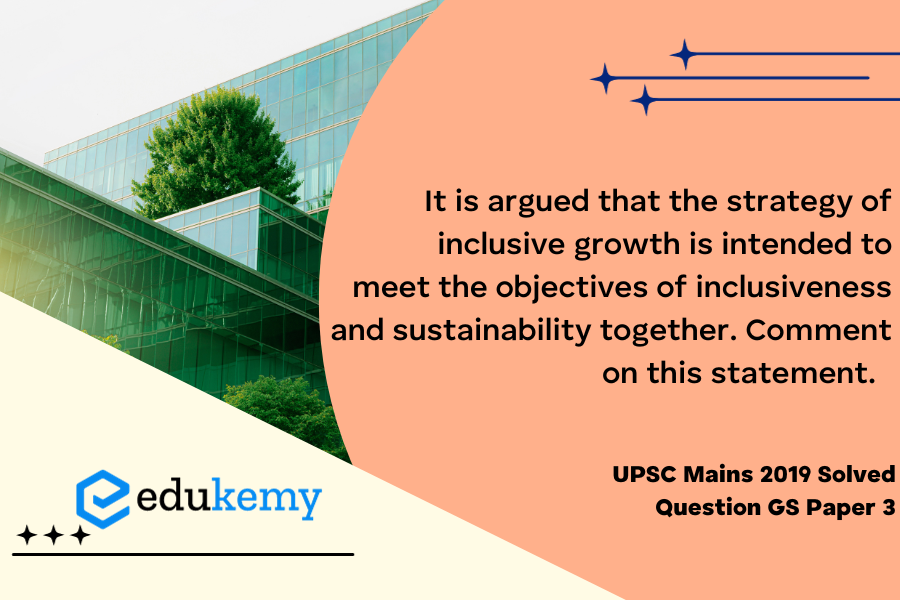The notion that the strategy of inclusive growth aims to simultaneously achieve the twin objectives of inclusiveness and sustainability is a compelling argument that reflects the evolving priorities of contemporary economic paradigms. Inclusive growth is a strategic approach that seeks to distribute the benefits of economic development equitably across different segments of society, bridging socio-economic disparities. The emphasis on inclusiveness underscores the importance of ensuring that the fruits of economic progress are not confined to a privileged few but are shared across diverse populations. This inclusivity is not only a moral imperative but also contributes to the overall stability and cohesion of society. Moreover, the integration of sustainability into this strategy recognizes the pressing need to harmonize economic progress with environmental and social considerations. Sustainable development, by definition, implies meeting the needs of the present without compromising the ability of future generations to meet their own needs. Therefore, embedding sustainability within the framework of inclusive growth aligns economic expansion with environmental conservation and societal well-being over the long term. In this way, the argument posits that inclusive growth, by addressing both inclusiveness and sustainability, offers a holistic and forward-looking approach to economic development that aspires to create a more just, resilient, and enduring socio-economic landscape. It underscores the interconnectedness of economic, social, and environmental factors, emphasizing the imperative to foster growth that not only lifts all boats but also ensures the durability of the sea they navigate.
Tag: Inclusive growth and issues arising from it.
Contents
Decoding the Question:
- In the Introduction, define the concept of inclusive growth.
- In Body,
- Discuss the ideas of inclusiveness and sustainability.
- Discuss the role of inclusive growth in achieving objectives of inclusiveness and sustainability.
- Conclude with writing the need for inclusiveness and sustainability while focusing on sustainable growth.
Answer:
According to the Organization for Economic Cooperation and Development (OECD), Inclusive growth is economic growth that is distributed fairly across society and creates opportunities for all. It refers to ’broad-based’, ‘shared’, and ’pro-poor growth’.

Triad of Inclusive Growth, Inclusiveness and Sustainability:
Inclusive growth must be based on Inclusiveness, which goes beyond mere economic inclusion.
- Inclusiveness is a concept that encompasses equity, equality of opportunity, and protection in market and employment transitions and is therefore an essential ingredient of any successful growth strategy.
Former President of India Pranav Mukherjee asserted, “Inclusive growth should not be a mere slogan but a fundamental driving force for sustainable development.”
- Sustainable development refers to the processes and pathways to achieve sustainability (e.g., sustainable ecology, sustainable production and consumption, good government, education, etc). Sustainability is a long-term goal for continuous inclusive socio-economic and ecological growth.
Inclusive Growth to Realize Inclusiveness and Sustainability:
- Reducing Poverty: Growth which is ‘inclusive’ and “pro-poor”, the incomes of poor people grow faster than those of the population, i.e., inequality declines. By focusing on inequality, inclusive growth could lead to optimal outcomes for all households.
- Distribution of Wealth: Inclusive growth helps in wider distribution of growth which creates demand in the economy and helps to lead domestic demand-driven economic growth.
- Withstand External Shocks: Inclusive growth builds strengths in the economy and growth becomes sustainable in the long term.
- Reduces Vulnerability: Inclusive growth helps in reducing the vulnerability of all types from the disasters of the present time and makes people and the community future-ready this ensures both inclusiveness and sustainability.
- Improve Quality of Life: With better income distribution the quality of life substantially improves materially.
- e.g., people move away from unsustainable energy sources such as cow dung, wood, etc. to clean energy sources such as LPG.
- Change in Development Model: Sustainable development brings the environment in its inclusion thus causing minimum depletion of resources and going for a circular economy.
- Resolving Structural and Fundamental Issues: Inclusive growth addresses fundamental and structural challenges in society and in the economy.
- For example, women empowerment initiatives like Self Help Groups will bring changes and enhance the participation of women in economic activity which will further lead to sustainability and inclusiveness.
It is due to this interrelation between this triad of inclusive growth, inclusiveness, and sustainability the government is aggressively focusing on the strategy of inclusive growth in its various programs and policies.
- E.g., Jan Dhan Yojana has focused on financial inclusion for all.
Thus, inclusive growth is necessary to promote sustainable development and inclusiveness. In the past two decades, India’s economic growth has been phenomenal, but it has underperformed on socio-economic indicators and Human Development Indicators. Therefore, in India’s context inclusive growth is an idea to realize the dream of sustainable and qualitative growth.
In case you still have your doubts, contact us on 9811333901.
For UPSC Prelims Resources, Click here
For Daily Updates and Study Material:
Join our Telegram Channel – Edukemy for IAS
- 1. Learn through Videos – here
- 2. Be Exam Ready by Practicing Daily MCQs – here
- 3. Daily Newsletter – Get all your Current Affairs Covered – here
- 4. Mains Answer Writing Practice – here


